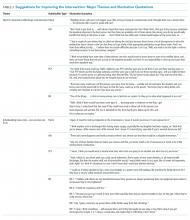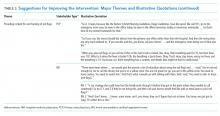A Qualitative Study of Increased Pediatric Reutilization After a Postdischarge Home Nurse Visit
BACKGROUND: The Hospital to Home Outcomes (H2O) trial was a 2-arm, randomized controlled trial that assessed the effects of a nurse home visit after a pediatric hospital discharge. Children randomized to the intervention had higher 30-day postdischarge reutilization rates compared with those with standard discharge. We sought to understand perspectives on why postdischarge home nurse visits resulted in higher reutilization rates and to elicit suggestions on how to improve future interventions.
METHODS: We sought qualitative input using focus groups and interviews from stakeholder groups: parents, primary care physicians (PCP), hospital medicine physicians, and home care registered nurses (RNs). A multidisciplinary team coded and analyzed transcripts using an inductive, iterative approach.
RESULTS: Thirty-three parents participated in interviews. Three focus groups were completed with PCPs (n = 7), 2 with hospital medicine physicians (n = 12), and 2 with RNs (n = 10). Major themes in the explanation of increased reutilization included: appropriateness of patient reutilization; impact of red flags/warning sign instructions on family’s reutilization decisions; hospital-affiliated RNs “directing traffic” back to hospital; and home visit RNs had a low threshold for escalating care. Major themes for improving design of the intervention included: need for improved postdischarge communication; individualizing home visits—one size does not fit all; and providing context and framing of red flags.
CONCLUSION: Stakeholders questioned whether hospital reutilization was appropriate and whether the intervention unintentionally directed patients back to the hospital. Future interventions could individualize the visit to specific needs or diagnoses, enhance postdischarge communication, and better connect patients and home nurses to primary care.
© 2020 Society of Hospital Medicine
Minor Themes
Participants also explained reutilization in ways that coalesced into 5 minor themes: (1) families receiving a visit might perceive that their child was sicker; (2) patients in the control group did not reutilize enough; (3) receiving more education on a child’s illness drives reutilization; (4) provider access issues; and (5) variability of RN experience may determine whether escalated care. Supportive quotations found in Appendix 2.
We directly asked parents if they would want a nurse home visit in the future after discussing the results of the study. Almost all of the parents in the intervention group and most of the parents in the control group were in favor of receiving a visit, even knowing that patients who had received a visit were more likely to reutilize care.
Goal 2: Suggestions for Improving Intervention Design
Three major themes and 3 minor themes were related to improving the design of the intervention (Table 1).
Theme 1: Need for Improved Postdischarge Communication
All stakeholder groups highlighted postdischarge communication as an area that could be improved. Parents were frustrated with regard to attempts to connect with inpatient physicians after discharge. PCPs suggested developing pathways for the RN to connect with the primary care office as opposed to the hospital. Hospital medicine physicians discussed a lack of consensus regarding patient ownership following discharge and were uncertain about what types of postdischarge symptoms PCPs would be comfortable managing. RNs described specific situations when they had difficulty contacting a physician to escalate care (Table 3).
Theme 2: Individualizing Home Visits—One Size Does Not Fit All
All stakeholder groups also encouraged “individualization” of home visits according to patient and family characteristics, diagnosis, and both timing and severity of illness. PCPs recommended visits only for certain diagnoses. Hospital medicine physicians voiced similar sentiments as the PCPs and added that worrisome family dynamics during a hospitalization, such as a lack of engagement with the medical team, might also warrant a visit. RNs suggested visits for those families with more concerns, for example, those with young children or children recovering from an acute respiratory illness (Table 3).
Theme 3: Providing Context for and Framing of Red Flags
Physicians and nurses suggested providing more context to “red flag” instructions and education. RNs emphasized that some families seemed to benefit from the opportunity to discuss their postdischarge concerns with a medical professional. Others appreciated concrete written instructions that spelled out how to respond in certain situations (Table 3).
Minor Themes
Three minor themes were revealed regarding intervention design improvement (Table 1): (1) streamlining the discharge process; (2) improving the definition of the scope and goal of intervention; and (3) extending inpatient team expertise post discharge. Supportive quotations can be found in Appendix 3.
DISCUSSION
When stakeholders were asked about why postdischarge RN visits led to increased postdischarge urgent healthcare visits, they questioned the appropriateness of the reutilization events, wondered about the lack of context for the warning signs that nurses provided families as part of the intervention, worried that families were encouraged to return to the hospital because of the ties of the trial to the hospital, and suggested that RNs had a low threshold to refer patients back to the hospital. When asked about how to design an improved nurse visit to better support families, stakeholders emphasized improving communication, individualizing the visit, and providing context around the red-flag discussion, enabling more nuanced instructions about how to respond to specific events.








